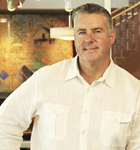Jeff Park knows a lot about growing by leaps and bounds. In 2006, he left the venture-capital firm Covington Capital Partners to become an executive vice president and CFO at SXC Health Solutions. The pharmacy benefit manager (PBM) had been one of Covington’s investments, and Park, a chartered accountant, had served on its board since 2003. But there’s a big difference between advising a company and managing its day-to-day financial operations.
Just months after joining SXC, Park guided its debut on the NASDAQ exchange. Over the next six years, he guided the firm’s unprecedented growth in tandem with CEO Mark Thierer, steering the company through eight mergers—earning Fortune’s number one Fastest-Growing Company in 2011. In 2012, SXC merged with Catalyst Health Solutions, doubling in size, and emerged with a new name: Catamaran Corporation. With more than 3,500 employees nationwide, Catamaran is now a $13 billion business, placing it comfortably in the Fortune 250. As the fourth-largest PBM in the United States by prescription volume, the company serves more than 25 million consumers and manages more than 200 million prescriptions. Park spoke with Profile about Catamaran’s rapid growth and his role in building an emerging health-care giant.
![]() The most important skills I brought to SXC centered on managing the commitments to and expectations of Wall Street. In my years as a venture capitalist, I spent a great deal of time interacting with investors. In those conversations, it’s important to set expectations and make sure you can meet or beat them.
The most important skills I brought to SXC centered on managing the commitments to and expectations of Wall Street. In my years as a venture capitalist, I spent a great deal of time interacting with investors. In those conversations, it’s important to set expectations and make sure you can meet or beat them.
When I joined SXC in 2006, these skills came in handy. The company wasn’t well-known among investors, so one of my main objectives was to share the company’s story with the investment
community and bring its competitive advantages to light. I also leveraged the M&A [mergers and acquisitions] skills I developed at Covington to help guide the due diligence and structuring of the numerous mergers and acquisitions we executed.
What I’ve Learned
Lessons in Rapid Growth
From Jeff Park
1.
“It’s so important to align the organization around the needs of clients. This means that every employee should know how their work specifically connects to a client’s success—everyone in the company plays a role.”
2.
“People can really make a difference in this industry, by saving lives and driving wellness.”
3.
“The larger you get, the only way to manage growth is through strict controls and the industry’s best people and processes.”
My experience has taught me that orchestrating a seamless integration during a merger or acquisition is the most critical path to success. This requires putting in the time and effort up front to focus on the specific nuts and bolts of the two businesses. Companies often make the mistake of leaving the plumbing alone, and, later on, when they struggle, they look back and wish they had paid more attention to the details. Notably, SXC’s recent merger with Catalyst was the largest we’d completed to date in the company’s history, so integrating our businesses correctly and setting them up for long-term success was even more important.
The business model at Catamaran is very straightforward. The company gets paid every time a prescription is filled. It’s our job to help our customers manage their health-plan costs. Since 85
percent of health-care dollars in this country are spent on physician or hospital visits, it benefits health plans to make sure they are using the lowest cost pharmaceuticals to help patients avoid hospitalization and unnecessary doctor visits.
When you look at Catamaran’s clients, we have a prominent footprint with many blue-chip accounts. The question for us is what other services and solutions can we offer them. Every client is
trying to provide better drug coverage for more members at a lower cost. However, they are all at different levels of sophistication—some require more assistance or services than others. When times are tough and the economy is struggling, consumers and companies are looking for more ways to save, and Catamaran is well positioned to offer customized solutions that drive increased savings. Our 99 percent client-retention rate is a testament to our dedication to this principle across our entire organization.
In recent years our acquisition strategy has been to buy our technology customers. Since they already use our technology platform, risk is mitigated and integration is seamless. In turn, these customers contribute their unique service offerings and competitive advantages to our business model, which we can then provide to all our clients. In effect, this is how we morphed Catamaran from a technology provider into a services and solutions company. Now, we are focused on acquiring other PBMs. Of the 100 competing PBMs in the marketplace, approximately 35 are currently using our technology platform, which processes one in five of all prescription claims in the nation.
Growing at hyper speed is not without its challenges. To manage a rapidly growing business like Catamaran, you need to make sure you have solid reporting, industry-leading analytics, and repeatable methodologies. And while Catamaran was founded and built upon this technology, it wouldn’t have become the company it is today without the tremendous work of our employees. This has been an area of great success for our company—ensuring we have the right people doing the right jobs.
Our industry-leading team is what made our recent merger with Catalyst possible, a transaction that effectively doubled the size of our business. This was an essential move in our company’s evolution, since, in the PBM industry, skill and scale are critical to success. Our merger with Catalyst, a customer of ours for 10 years, doubled our scale so we can compete on an even higher level, moving upmarket to attract a client base that has traditionally been served by larger PBMs: Fortune 500 companies.
Looking ahead, Catamaran’s future is bright, with unlimited opportunities for future growth. First, our country’s aging population continues to drive increased consumption of health care. Also, the US government will now be providing more health care to more people via the Affordable Care Act. Combined, this creates a larger population of individuals in need of medication. Our industry is accelerating and our job is to help reduce costs by looking at ways to lower the cost of prescription medication and drive regulatory compliance. While our growth has been dramatic, our market share is approximately eight to nine percent, which means there is still room for growth and plenty of opportunities ahead. ![]()















